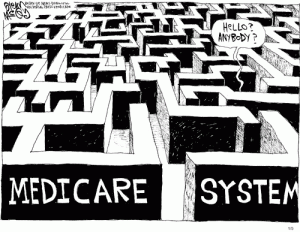By Jack Cumming
During one of those online long-term care panel presentations that are so common these days, one of the panelists said, “Boomers want healthcare to be ‘behind the walls’ rather than in the front.” That confident assertion by a panelist who was clearly also a boomer gave me pause. How would senior living adapt if the world adhered to the panelist’s vision?
Ageless Admissions
First, I surmised, there would be no minimum age for admission. It might be that most residents would be people of a certain age. And they might take comfort from knowing that unseen care was somewhere, just not in sight and certainly not front and center, as is the case for a Continuing Care Retirement Community (CCRC), Life Plan Community (LPC), Assisted Living, or single-level Independent Living Community.
The minimum age requirement signals to prospects that a “community” is a facility for old folks. Many prospects are not ready to concede that they are old. Even the Active Living 55+ segment shouts old age and endless recreation without purpose. Instead, some people – a growing proportion of people – hope to remain productive throughout life.
There’s evolving evidence that staying productive delays cognitive decline. Of course, it may simply be that people who stay cogent are the ones who enjoy working and who are able to do so. Still, if the dream of a do-nothing retirement is giving way to a new dream balancing purpose, meaning, recognition, and freedom, the active recreational dream may be losing its luster.
Continuing Care?
Second, there’s that “continuing care” contract. That agreement is the heart of the sales drama for many senior living enterprises. The signature on that contract signals the close of the sale. The contract promises the availability of conditional care when and if it is required. That forces the conversation to be one around the decline that many associate with aging.
Care brings up images that may no longer be relevant. Picture President Biden clearing his throat, or hobbling a bit as he tries to scurry to appear youthful, or stumbling as he scrambles up the steps of Air Force One. We can choose to see him as an old person ready to sign a continuing care contract, or we can see him as a vital, vigorous national leader. If you were President Biden’s age, how would you prefer to be seen?
Nursing Home Administrator?
Third, you may not think that the qualifications of the Executive Director are relevant to marketing, but many prospects, as they become serious, want to meet the Executive Director. After all, most continuing care contracts give extensive unilateral powers to the Executive Director. Meeting the person who is going to make those care, financial, and other decisions before signing the contract seems only rational.
Given those care decisions, it’s not surprising that many Executive Directors are Certified/Licensed Nursing Home Administrators. During the introductory meeting, the Director may even cite that training as critical. At a minimum, that nursing home orientation is likely to impact the vocabulary and focus of the Director. Those attributes can color the impression that the prospect takes away from that conversation. The message: healthcare is very much “front of house.”
Few people who expect to remain independent indefinitely, and who merely want to simplify the daily grind, are likely to be attracted by the prospect of nursing home confinement. A Certified/Licensed Nursing Home Administrator designation, as admirable though it may be, is not consistent with the emerging ideal of healthcare “behind the walls.” Perhaps healthcare on standby and out of sight was always the preference, but increasingly as old age becomes less disabling, it’s more true today than ever.
Affordability
Lastly, there’s that looming affordability question. Senior housing costs far more than conventional multi-family alternatives. Moreover, there’s the hurdle for many of an entrance fee that gives only murky value to those who agree to pay it. There are many prospects who walk away merely because of the entrance fee. They are lost customers. The alternative is to surround conventional housing with the services that are often needed by older people.
That alternative may be most readily delivered in naturally occurring aging settings among the longtime residents in multi-family dwellings. New connectivity possibilities make it possible everywhere. That can lead to the decoupling of senior housing, per se, from “senior living” in the larger sense. It is becoming evident as well that aging in place is not only the preferred choice, but it’s the lower cost choice as well. Senior housing enterprises tend to carry a heavy overhead burden. It’s time to rethink the core business model.
Consolidation
Recently two topics seem to prevail in conversations among industry leaders. Topping the list is the workforce challenge. Not far behind is the growing awareness that consolidation is needed to cope with the labor situation and the rapidly evolving digital world. Those two challenges are interrelated.
Airbnb, for instance, came out of nowhere as a nationwide entity. That kind of approach has the potential to outrun consolidation and to force more rapid change in senior living. App-based employment scheduling is now gaining momentum. Decoupling benefits from employment may provide the fuel that rockets flex-work into a gig economy future. Already, senior living employment is becoming more flexible and more worker-friendly to the benefit of some and the dismay of others.
In business, consolidation – like that beginning to accelerate in senior living – is often a sign of weakness as an industry passes its peak and entropies toward stagnation. Remember the collapse of the railroad industry in the 1970s. Today’s railroading was shaped by the 1974 formation of the Consolidated Rail Corporation (Conrail) as a government-funded private company. Some favor a similar bailout for senior living, especially now with a Democrat in the White House.
Consolidation, however, is unlikely to spare senior living from dramatic change any more than it has restored railroads to their earlier ascendancy. Consolidation and size are intended to bring about business efficiency and rapid adaptation to changing markets and culture. Efficiency, however, is difficult for nonprofits to achieve.
First, nonprofits only consolidate with the consent of both entities. There is no possibility for an interventional takeover. That means that the merger negotiations often have to protect central office interests and perpetuate overhead that otherwise would be unnecessary. That limits the ability of an entrepreneurial takeover executive to act swiftly and to realize obvious economies.
Second, nonprofits pride themselves on being more charitable than moneywise, so the impetus toward value is less pronounced than in the wider business culture. The superficial benefits from avoiding taxes and dividend payouts are often lost to the lack of money consciousness and the reluctance of some nonprofit executives to cut costs and to invest in cutting-edge technologies.
An Optimistic Future
For the industry to grow and thrive, it has to respond to changing expectations about aging. We’ve mentioned President Biden, though that’s only a prominent example of a trend that is widespread. More and more, octogenarians are making a difference and contributing productively to the lives and welfare of people of all ages.
Sure, there are younger people who would love nothing more than to see them “aged out” to create more opportunities for youth. That’s a lingering bias that has no place in an industry that exists to serve those of a certain (unmentionable?) age. To do otherwise is to perpetuate the ageism which the industry decries in its messaging.
If the senior living industry truly moves beyond the ageism which its leaders denounce, there is a bright future of growth and opportunity beckoning. Imagine the opportunity that lies ahead for an entity with national scope enriching the lives of people instead of merely providing care when a family crisis leaves no choice. That’s a huge opportunity just waiting for the next Amazon to come along to show the way into the future. It’s easier to adapt and change to meet emerging customer expectations than it is to defend the status quo. The acceleration of change, which is a byproduct of the pandemic, calls for boldness either from within or without.










